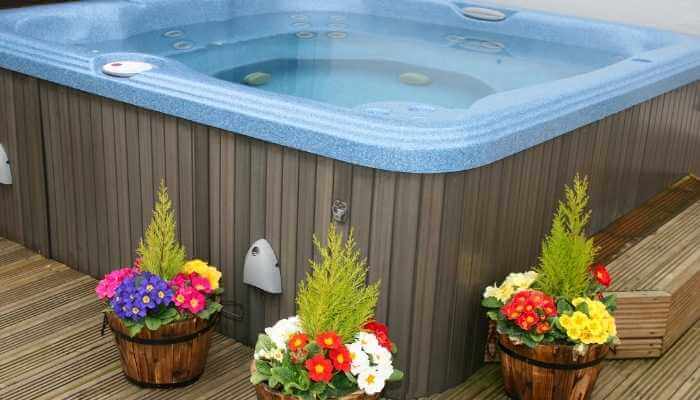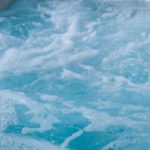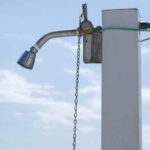Each person has their own style and preference when it comes to their patio. I personally love flagstone patios, or mixed stone and paver patios. But, what if you have a specialty patio, then decide to get a hot tub? Can you put a hot tub on a paver patio? What about on flagstones or a stamped concrete patio?
You can definitely place a hot tub on a specialty patio such as wood, composite wood, pavers, flagstone, or stamped concrete. However, you’ll need to take some extra steps and spend a little extra money to ensure your investment and keep your hot tub working and safe for the long run.
Want to know the advantages and disadvantages of placing a hot tub on each type of specialty patio? I can give them to you – just keep reading!
Are Paver Patios Good Bases for Hot Tubs?
To have pavers that can support a hot tub, they need to be at least 2 inches thick. Also, most paver patios will have a slope for drainage. This needs to be taken into consideration. After all, you want the hot tub to be level.
Just like flagstones – pavers can sink and settle after the placement, thanks to the cycles of freezing and thawing as weather changes in certain climates. This can cause not only instability but constant wear and tear to your tub. As always, if you want to protect your investments, get a professional to inspect the patio and make sure it and the hot tub are perfectly balanced.
Usually, the point of installing a paver patio is to enjoy the aesthetically pleasing designs that are possible. But you plan on putting a hot tub on top of it. It’s not like anyone is going to see the pretty design you’ve made with the pavers if it’s underneath the hot tub. So consider this, when you look at the expense you’re about to go to for a hot tub pad.
If you do it yourself and you aren’t worried about the aesthetic, pavers could end up being a good deal. They hold up as well as concrete and they have a low absorption rate compared. They’re easy to replace if anything goes wrong and you don’t have to wait 28 days for them to cure before moving your hot tub onto them.
Flagstone Patios
I consider flagstones to be a type of paver, really. The difference is that natural stone or flagstone are random sizes and they may be different thicknesses when you get them. The base for laying them will need to be something like sand that can be tamped to adjust for the difference and I can tell you from experience – getting these bad boys level is nearly impossible. Even professionals have a rough time with that.
The main concern about placing a hot tub on flagstone or natural stone is of course getting the tub level and keeping it that way. Because these stones are not one full and solid piece, settling can occur on one area that doesn’t happen on the other.
They also shift over time due to weather and climate. Your hot tub will be sitting on uneven ground, which can cause damage in the long term. So, I wouldn’t suggest this specialty patio for the actual base for your hot tub to sit on. But, there are workarounds. Just keep reading.
Wood Decks
Putting a hot tub on any kind of elevated decking involves hiring a structural engineer or a qualified building contractor to be sure the weight of the hot tub can even be supported by the deck. You have to know the maximum load capacity of the hot tub from the manufacturer – how much it’ll weigh with water and people inside of it. Reinforcements may need to be made.
The main thing to be careful of when it comes to decking (once you’ve been sure it can support the hot tub) is moisture. When you have any base made of wood, supporting something heavy that is also the source of splashing water – rot is something to constantly be on the lookout for. Definitely be sure to treat, stain, and/or paint your wood to protect it as much as possible.
Something a lot of people don’t think about is the age of an existing deck, should you plan on using one. This is why getting a professional contractor or a structural engineer is so important. The materials on an older deck might be worn. The construction standards might be different from current guidelines and codes. This needs to be addressed to keep your hot tub and everyone that uses it safe.
Composite Decks
Since we’re talking about wood decks, might as well hop into composite wood decks. Composite wood is a blend of plastic, (usually recycled) wood, and additives. Because of this, you don’t have to worry so much about rot when it comes to a composite wood deck – the materials are water-resistant.
The important thing to remember – for safety’s sake – is getting a professional contractor or structural engineer to be sure that your composite wood deck can handle the maximum weight load of the hot tub you plan on getting. If not, reinforcing an elevated deck may be the answer. If you’re building a deck specifically for a hot tub, just be sure your contractor chooses materials that will be strong enough.
Stamped Concrete Patios
The design may get damaged by placing the hot tub on it. But if you don’t plan on ever moving the hot tub while you live there, that shouldn’t be an issue. Just remember that you’re losing a lot of the aesthetic appeal by putting a hot tub over the design in the first place.
Also, from what I understand, there is usually a slope from run-off when it comes to stamped concrete. So that needs to be taken into consideration at the installation of the tub or it could cause issues. I was told that if you’re having the concrete installed and the professional knows it’s for a hot tub, they can usually plan for it.
Otherwise, using this as a base for your hot tub is no different than using standard poured concrete. So long as your concrete is at least 4 inches deep and was properly installed, it should be a nice even solid base that withstands the wear and tear of the weight of the hot tub. The only problem would be if it cracks – but that means the concrete wasn’t properly installed or cured before the hot tub was installed.
Keep in mind that if the concrete was sealed properly, there might be a bit of slipperiness involved. That can be planned for, of course.
And in closing…
I would caution you to get a professional to install your base and hot tub. If you already have the foundation, the pro can tell you what you need to change to keep your investment in the hot tub lasting as long as possible. If you’re doing everything from scratch, having a professional contractor install the patio while knowing what it’s for is ideal. The main thing is – I don’t feel like this is a project you should consider DIY.
No matter which specialty patio you might have – if your hot tub installer is a professional about it, they can spot an issue. If push comes to shove, joists, new framing, or different means of support and reinforcement can be settled over the existing patio and the hot tub can be leveled, even if the patio is not.
There are alternative workarounds. So don’t give up! This article is just to help you keep in mind some of the problems you might run into with specialty patios when installing a hot tub. They aren’t meant to discourage you from getting your outdoor living space the way you want it – hot tub included.
I wrote an article covering the best bases for hot tubs that you can find here.













